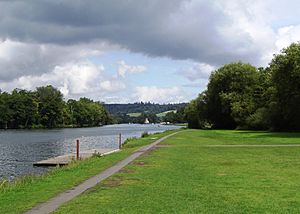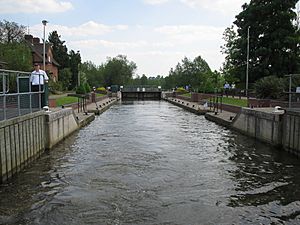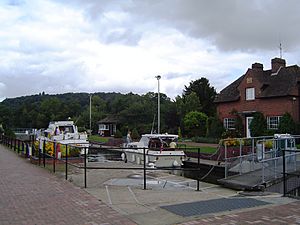Hambleden Lock facts for kids

An old tug boat leaves the lock
|
|
| Waterway | River Thames |
|---|---|
| County | Berkshire |
| Maintained by | Environment Agency |
| Operation | Hydraulic |
| First built | 1773 |
| Latest built | 1994 |
| Length | 61.00 m (200 ft 2 in) |
| Width | 7.70 m (25 ft 3 in) |
| Fall | 1.44 m (4 ft 9 in) |
| Above sea level | 101' |
| Distance to Teddington Lock |
43 miles |
| Power is available out of hours | |
Hambleden Lock is a special kind of gate on the River Thames in England. It helps boats move up and down the river. There's also a long weir here, which is like a small dam that controls water flow.
The lock is on the Berkshire side of the river. It sits between the villages of Aston and Remenham. The lock was built in 1773 by the Thames Navigation Commission. It gets its name from the village of Hambleden, which is about 1.5 kilometers (1 mile) north.
Near the lock, you can see a big weir. There are walkways over this weir. These walkways connect the lock to a small village called Mill End. On the Buckinghamshire side, you'll find the pretty Hambleden Mill. Also, the remains of an old Roman villa are close by.
Contents
History of Hambleden Lock
The mill at Hambleden is very old. It was even mentioned in the Domesday Book. This means there was likely a weir here a long time ago. Records from 1338 talk about a weir with a winch. A winch is a machine used to pull boats through a type of lock called a flash lock.
Hambleden Lock was one of the first "pound locks" built on the Thames. These locks were made after a special law in 1770. The first locks were made of fir wood. This wood didn't last long, so they had to be replaced with stronger oak wood.
In 1777, a small brick house was built for the lock keeper. Caleb Gould became the first keeper. He was a bit unusual! He baked bread for boatmen and ate onion porridge every night. He worked at the lock for 59 years. His son took over after him.
People still used the old flash lock system until the mid-1800s. In 1825, a new channel was dug. This channel helped boats avoid the weir and its strong currents. The lock was completely rebuilt in 1870 because it was in bad shape. New weirs were built in 1884. After people complained, the walkway was added to let people cross the river again. The lock was rebuilt again in 1994.
How to Reach the Lock
You can get to Hambleden Lock from the village of Aston. It's a short walk from there. Look for the path just west of the Flower Pot pub.
If you are on the other side of the river, you can use the walkways. These walkways go across the weirs from Mill End. They make it easy to reach the lock.
The River Above Hambleden Lock
As you go upstream from the lock, the river bends south. On the Buckinghamshire side, you'll see Greenlands. This is a large country house built in the 1800s. Today, it's home to the Henley Management College.
After the bend, you'll spot Temple Island. This island marks the start of the famous Henley Royal Regatta course. The regatta is a rowing race. It takes place on a wide, straight part of the river. The course is about 2,112 meters (1 mile, 550 yards) long.
On the Berkshire side, there are open fields and lawns. You'll also see Remenham Farm, which is part of the village of Remenham. The regatta lawns continue up to Henley Bridge. The town of Henley-on-Thames is on the Oxfordshire side of the river.
The annual Henley Festival also happens here. It stretches from just upstream of Hambleden village to just before the next lock, Marsh Lock.
Past Henley Bridge, you'll find the Henley river front. Here you can rent boats or take a river cruise. After a small wooded island, there's a larger island called Rod Eyot. Mill Meadows is a public park on the Henley side. The River and Rowing Museum is also located here. On the Berkshire bank, the land rises steeply. A wooded hill hangs over Marsh Lock.
Sports Clubs on the River
Many rowing clubs are located on this part of the river:
- Upper Thames Rowing Club
- Remenham Club
- Leander Club
- Henley Rowing Club
Thames Path Walking Trail
The Thames Path is a long-distance walking trail. It stays on the Berkshire bank up to Henley Bridge. This part of the path is well-maintained. This is helpful for rowing coaches who cycle along it. The path then crosses Henley Bridge. It continues on the Oxfordshire bank towards Marsh Lock.
Kayaking and Canoeing at the Weir
Since the 1940s, people who enjoy kayaking and canoeing have used the weir for fun. The weir has special ramps in four places. These ramps are made of concrete and are about 16 degrees steep. On top of these, there are hinged steel plates. These plates can be adjusted to be steeper, up to about 28 degrees. Air-filled bellows help to adjust the steel plates.
Hambleden Lock in Books and Media
The writer Jerome K. Jerome wrote about this area. He mentioned "the rather uninteresting river residence of my newsagent". He described him as a "quiet unassuming old gentleman" who would scull along the river. This newsagent was W H Smith, and his home was Greenlands.
Caleb Gould, the lock keeper, has a gravestone in Remenham. It has a short poem on it:
This world’s a jest,
And all things show it;
I thought so once,
And now I know it.






